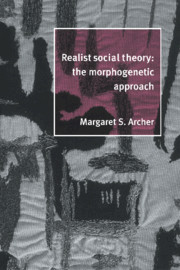Book contents
- Frontmatter
- Contents
- List of figures
- Acknowledgements
- 1 The vexatious fact of society
- Part I The problems of structure and agency: four alternative solutions
- 2 Individualism versus Collectivism: querying the terms of the debate
- 3 Taking time to link structure and agency
- 4 Elision and central conflation
- 5 Realism and morphogenesis
- Part II The morphogenetic cycle
- Index
4 - Elision and central conflation
Published online by Cambridge University Press: 02 December 2009
- Frontmatter
- Contents
- List of figures
- Acknowledgements
- 1 The vexatious fact of society
- Part I The problems of structure and agency: four alternative solutions
- 2 Individualism versus Collectivism: querying the terms of the debate
- 3 Taking time to link structure and agency
- 4 Elision and central conflation
- 5 Realism and morphogenesis
- Part II The morphogenetic cycle
- Index
Summary
Duality: structure and agency as ontologically inseparable
To view structure and agency as fundamentally inseparable is certainly novel, for it asserts something much stronger than their necessary relationship. It means that we are basically talking about one thing, since even if it is an amalgam then it can only be treated as such. This is Craib's view: ‘instead of separate and opposing things in the world or as mutually exclusive ways of thinking about the worlds they are simply two sides of the same coin. If we look as social practices in one way, we can see actors and actions; if we look at them another way we can see structures’.
If someone were to insist in the Elisionists' defence that an amalgam still has two constituents, it nevertheless remains the case that for them we are compelled to see the two only in combination and constrained to regard this combination of being of a particular kind. As Thompson puts their view of the matter, ‘Rather than seeing action and structure as counter-acting elements of a dualism, we should regard them as the complementary terms of a duality, the “duality of structure”.’ In turn, this spells a shift away from traditional procedures and indicates a new focus for social analysis. Now what ‘must be grasped is not how structure determines action or how a combination of actions make up structure, but rather how action is structured in everyday contexts and how the structured features of action are, by the very performance of an action, thereby reproduced’.
- Type
- Chapter
- Information
- Realist Social TheoryThe Morphogenetic Approach, pp. 93 - 134Publisher: Cambridge University PressPrint publication year: 1995



